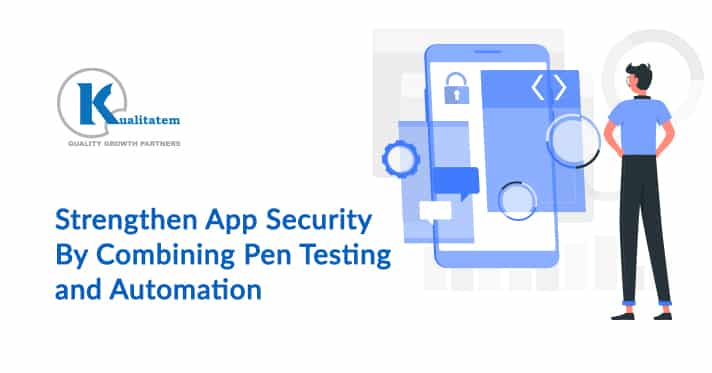Strengthen App Security By Combining Pen Testing and Automation

- June 30, 2020
- HibaSulaiman
The emerging digital technologies and platforms enable organizations to deliver agile products, enhance operational efficiency, and increase business revenues. However, deploying changes faster to rapidly deliver software apps is a daunting process. So what happens when changes in an app contain bugs or security issues? If companies take no measures to protect against releasing buggy apps, the risk of earning a bad reputation to business is higher. Thus, in this ever-evolving and challenging software space, businesses need a new proactive approach.
As machines and robots have taken over the day to day jobs that once only humans could complete, they fear that automation will take over all manual tasks. No matter how far technology takes us, human intervention will always be required in the decision-making process. We know the importance of human skills when it comes to software testing. With respect to penetration testing, although machines can identify many vulnerabilities, human testers are still necessary to measure the severity and resolve these issues.
In this article, we shall see how a business can hire a penetration testing company and strengthen its app securing by combining manual penetration testing and automation security testing:
Penetration Testing and Vulnerability Scan
Firms use vulnerability assessments or scans to report known vulnerabilities within an IT network. These scans are carried out on a regular basis so that the basic security measures are in place. However, these scans can only alert a business about vulnerabilities in its systems but do not perform any further action.
On the other hand, penetration tests are different from vulnerability scans and much more complex. They evaluate the security of an environment by exploiting its weaknesses, breaching networks with a variety of tools in order to simulate what to expect if the firm was attacked by a hacker. These tests are more expensive and work as a roadmap for organizations to know how to remediate the identified vulnerabilities. Pen-testing varies from environment to environment and requires a combination of skills to successfully exploit weaknesses in an environment.
Innovative Testing Techniques for Modern Software Apps
Firms looking forward to an effective and comprehensive testing approach combine manual penetration testing and automated security testing processes. Manual pen-tests identify complex attack vectors. But the increase in the amount of code pushed daily poses challenges as it becomes difficult for security teams to maintain a record of the latest threats and risks. These problems can be identified before the new code is sent into production by using automated testing tools.
Combining Pen-Testing and Automated Security Testing
Developers can identify and solve security issues throughout a software development lifecycle with the help of automated tools. When development teams resolve security issues before implementing production updates, pen-testers focus on complex vectors, reducing the time and cost.
Since pen-testing tools are becoming more popular, there is a common misconception that pen-testing will be as easy as running an automatic software. Although pen-testing tools have automated capabilities, yet the entire process is not automatic. Manual testers need to be involved to chose which automation pen tests should run. For instance, there are some pen-tests that allow beginning pen-testers to run their tests by introducing automation step by step. These pen-tests cover high-level tasks in certain areas. Automation ensures making the pen-testing process more effective, but it cannot replace the manual pen-testers. Let’s take an example of conducting phishing emails and data collection of all those who opened the social engineering emails that can be automated. However, pen-testers need to research which phishing emails are more effective, create the content of these emails, and analyze data to view the trends.
Pen-tests aim at imitating real-world attacks which are performed by cyber-criminals with intentions to gain access to either harm a business or misuse the information for their personal gains. Normally, computer systems are not capable of attacking other systems. Thus, to replicate human attackers, human pen-testers are required to think like them. Given that organizations are becoming more aware of strengthening their security defenses, so are the threat actors. As a result, pen-testers have to be more creative. The only pen-testers can be successful is by exploiting vulnerabilities in their systems that attackers can otherwise use to achieve their targets. There are certain factors organizations need to focus on, that includes configuring IT systems with other departments, ensuring centralized security, or other security loopholes that can be breached by attackers.
Typically, attackers also use tools to make successful breaches and so do the pen-testers. These automated pen-testing tools are used to augment human capabilities, however, they can never replace manual testers. So, both pen testing and automation need to be aligned and the right combination will help organizations achieve the security they are looking to implement on their systems, networks, and applications. Penetration testing tools are used to automate several tasks in order to improve the security and performance issues of an application.
Conclusion
Organizations combine vulnerability scanning, threat intelligence, and human pen-testers to validate the vulnerabilities identified through simulated attacks on IT systems. Security experts are employing automated testing and manual pent-testing to assist their penetration testing efforts. Human expertise has played a critical role in penetration testing but today’s security professionals are moving towards automation penetration testing tools to improve the testing processes. However, this will never eliminate the need for manual testing efforts. In the near future, security professionals speculate that Artificial Intelligence (AI) can assist in vulnerability analysis by extracting information from services running on target systems.











